Snapshots: Premiums, Cost-Sharing and Coverage at Public, Private and Non-Profit Firms
There are important differences in the legal organization and mission of different employers in the United States. In addition to collecting information about premiums and employee cost sharing, the 2012 Employer Health Benefits Survey asked respondents to characterize their ownership structure. Respondents were asked to describe their organization as either a “private firm, including publicly traded companies and privately owned businesses,” “a public firm, such as a state or local government agency,” or as a “non-profit, such as a 501(c)(3).”1 Sixty-one percent of workers covered by a health plan are employed by a private firm, 17% are employed by a public employer, and 22% are employed by a non-profit employer.2 Since public and non-profit employers tend to have more workers on average, a larger portion of the total number of employers is comprised of private firms.
There are important differences in the health plans being offered by employers in each of the three ownership categories. On average, workers covered by health plans at privately owned firms are required to pay higher premium contributions for both single and family coverage. At the same time, these workers face higher cost-sharing requirements when they access services.
Premiums and Worker Contributions
For both single and family coverage, covered workers at private firms are enrolled in plans with less expensive premiums ($5,297 and $15,199, annually) than covered workers in the two other ownership categories. The average premium is made up of both a worker contribution and an employer contribution. While, on average, covered workers are covered by plans with less expensive premiums at private firms, they are responsible for a larger share of the total premium than their counterparts at public and non-profit employers. On average, the employer contribution for covered workers enrolled in family coverage at private employers is $10,704, less than the average public employer contribution ($12,381) and non-profit employer contribution ($12,697). Covered workers at public employers have the smallest worker contributions: $3,368 for family coverage and $698 for single coverage.
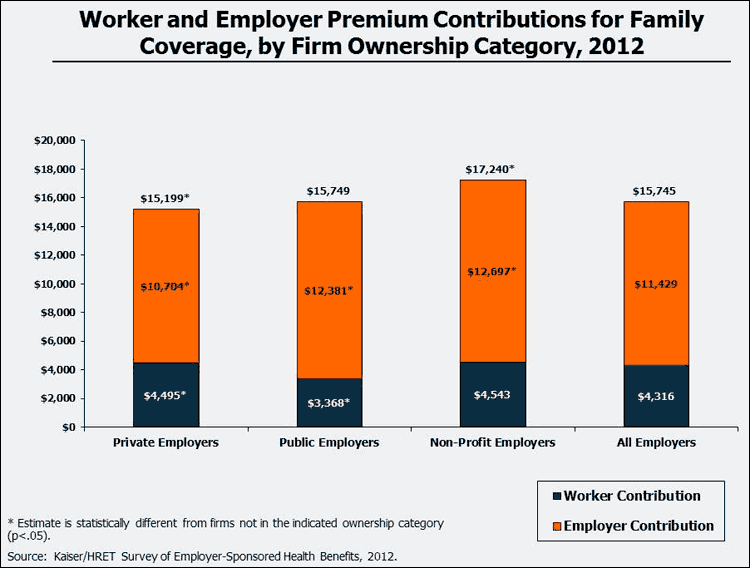
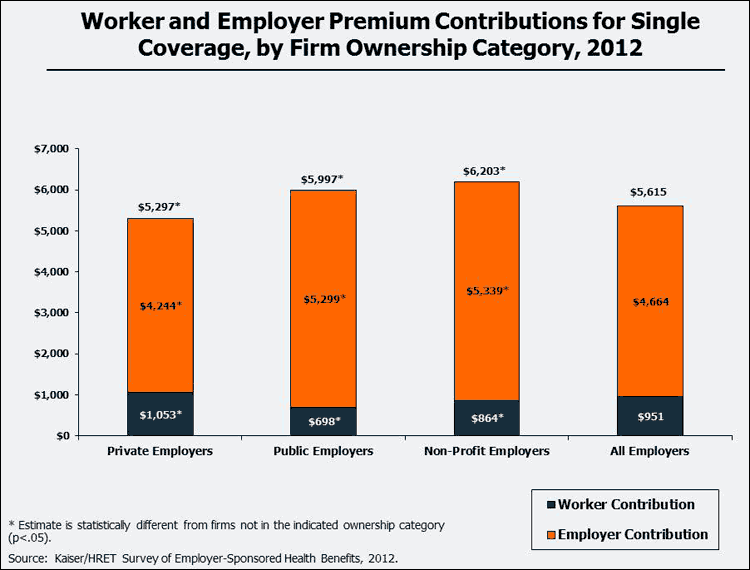
There are important differences in premium contributions when comparing types of employers within size categories. Covered workers at private employers are covered by less expensive family premiums both when the worker is at a small employer ($14,595) (3-199 workers) or a large employer ($15,544) (200 or more workers) when compared to employers in other ownership categories. In addition, covered workers at private employers receive smaller employer premium contributions then covered workers in the other ownership types at both small and large employers. Workers at public employers contribute the smallest amount to their premium at both small ($2,894) and large employers ($3,462).
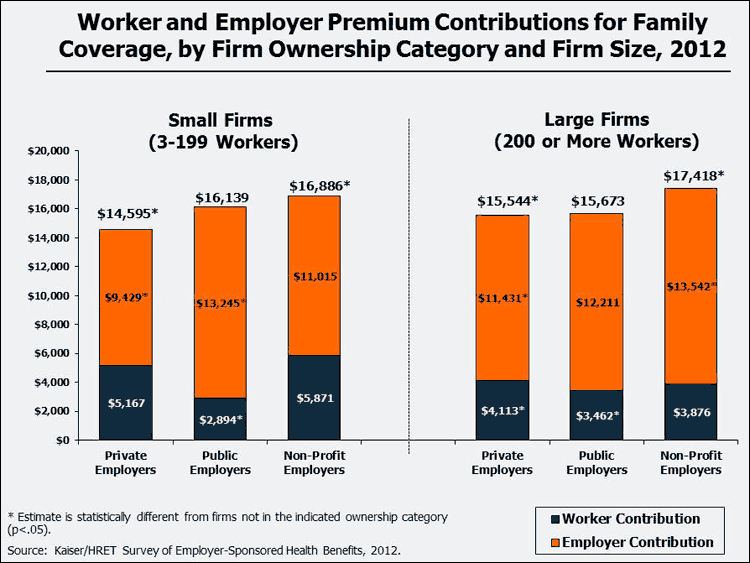
On average covered workers at public employers are responsible for a smaller portion of the premium than covered workers employed in the other ownership categories. Covered workers at public employers contribute 12% of the cost of single coverage and 23% of the cost of family coverage. Conversely, covered workers at private employers contribute a larger percentage of the premium than covered workers in the other ownerships types; workers at private employers contribute 20% of the premium for single coverage and 30% of the premium for family coverage.
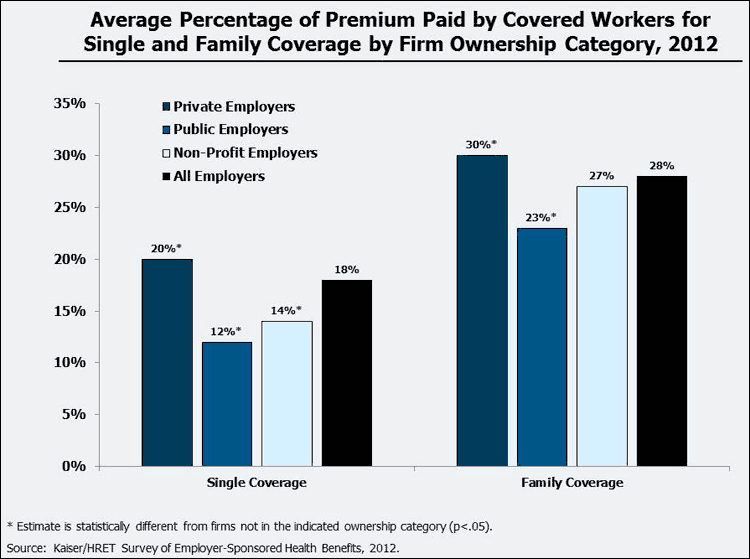
There is significant variation in workers’ premium contributions within employer ownership type. A majority of covered workers at private employers are responsible for more than a quarter of the family premium (57%). Conversely, over half of covered workers at public and non-profit employers are enrolled in plans in which they contribute a quarter or less of the family premium.
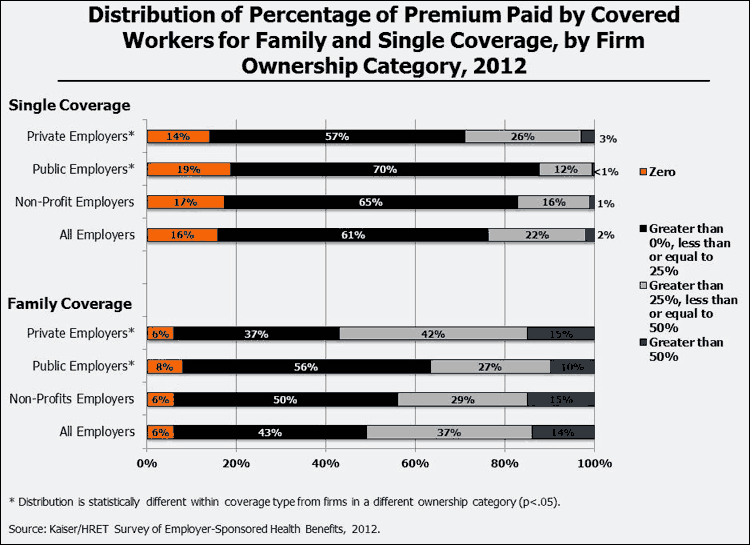
Employee Cost Sharing
In addition to being responsible for a larger proportion of premium costs, workers at private employers face higher cost-sharing requirements when they access services.
A general annual deductible is an amount that must be paid by the enrollee before all or most services are covered by their health plan. On average, workers at private employers face higher deductibles before services are covered: 41% of covered workers at private employers face a deductible of a $1,000 or more compared to 15% at public employers and 26% at non-profits. Seventeen percent of covered workers at private employers are required to meet a deductible of $2,000 dollars or more.
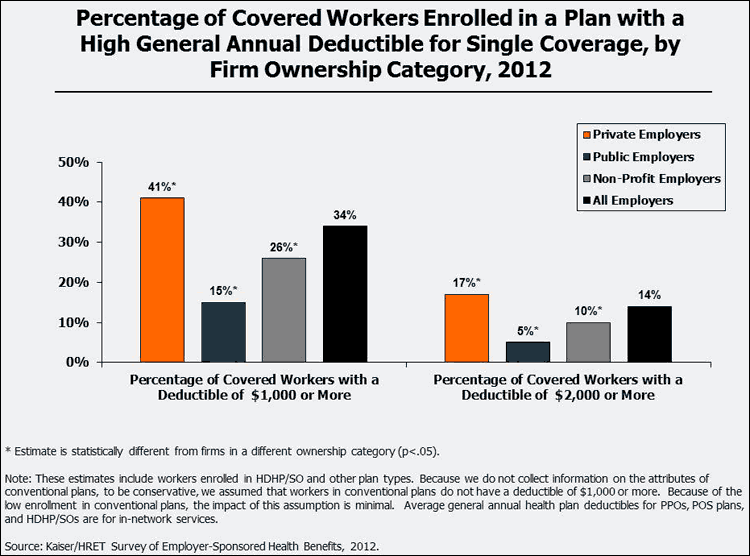
In addition to the general annual deductible, workers are often required to pay a coinsurance or copay for visits with health care professionals. Covered workers at private employers are more likely to be required to pay a coinsurance rate and less likely to pay a copay for primary and specialist office visits than workers at other types of employers. Depending on the coinsurance rate and whether the cost-sharing formula includes minimums and maximums, coinsurance rates often place a greater financial burden on workers for high cost services than a copay.
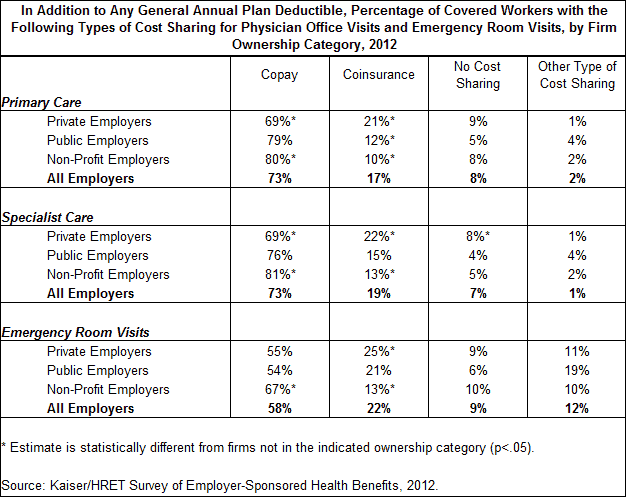
Among covered workers who face copays for office visits or emergency room visits in addition to the general annual deductible, workers at private employers face higher average copays than their counterparts at non-profit and public employers. On average, covered workers at private employers have copays of $24 for primary care office visits, $35 for specialist visits, and $124 for emergency room visits.
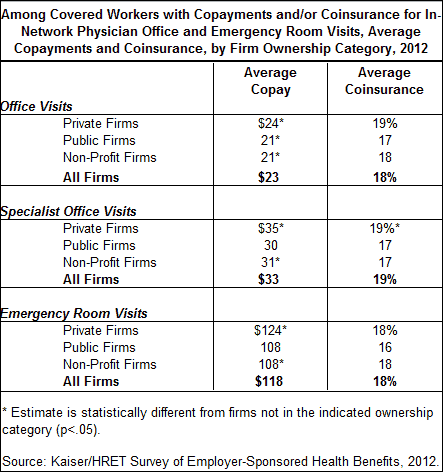
Coverage and Enrollment
The number of workers eligible and covered by an employer’s health benefits varies by ownership category. Among public employers offering health benefits, 75% of workers are covered by their firm’s health benefits plan, more than the 59% at private employers and 63% at non-profit employers. The number of workers covered by health benefits is the product of how many workers are eligible to enroll and how many “take-up” or participate in that coverage. Public employers have both a higher eligibility rate and a higher take-up rate. Eighty-three percent of workers at public employers that offer coverage are eligible to enroll. Among workers eligible to participate in health benefits, 90% of covered workers at public employers take-up coverage, significantly more than the 78% that take-up at private employers and the 83% that take-up at non-profits.
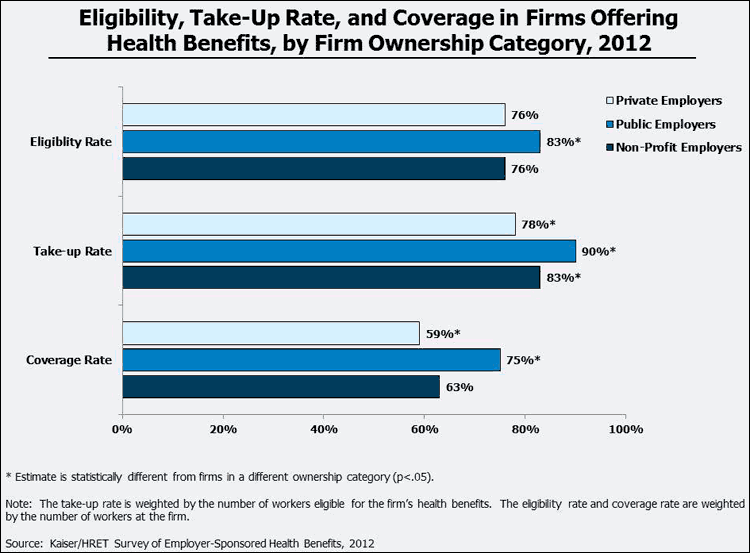
Covered workers at private employers are more likely to be enrolled in a high-deductible health plan with either a health reimbursement arrangement (HRA) or a health savings account (HSA) compared to covered workers in other ownership categories. Similarly, covered workers at public employers are more likely to be enrolled in a PPO plan.
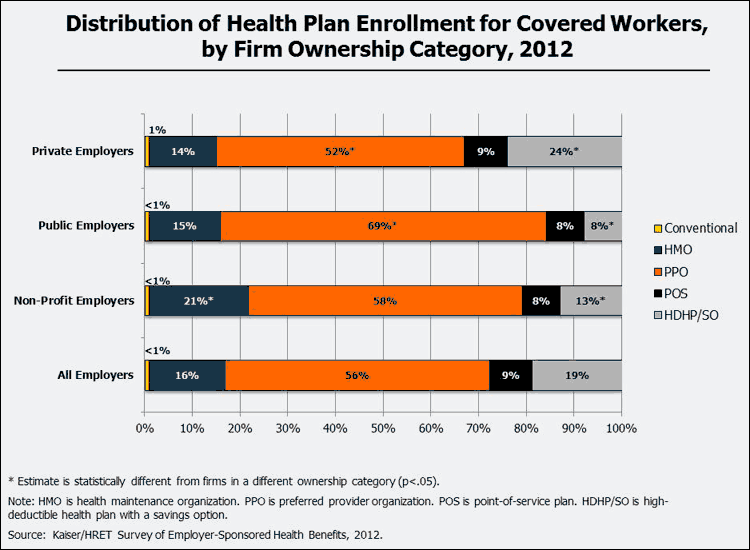
Other Notes
There are other important differences in the health plans being offered at private, public and non-profit employers. Among large firms offering health benefits, a significantly greater percentage of public employers (63%) offer retiree benefits compared to private (18%) or non-profit employers (23%).
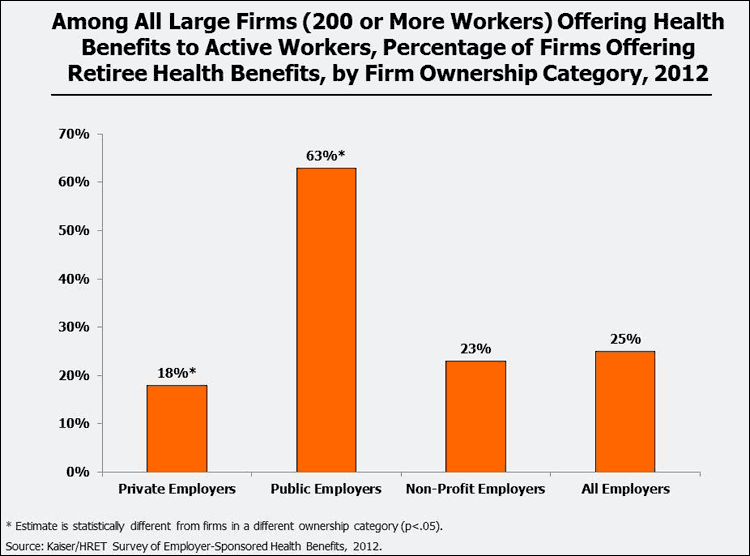
In order to reduce health costs and improve employees’ health, many employers offer wellness programs. The survey asks employers who offer health benefits if they offer one of eight specified health programs or another unspecified program. A significantly higher proportion of public employers offer at least one of the specified wellness programs or an unspecified program (96%). Public employers are more likely to offer weight loss programs (62%) or web-based resources for healthy living (72%) than employers in other ownership categories.
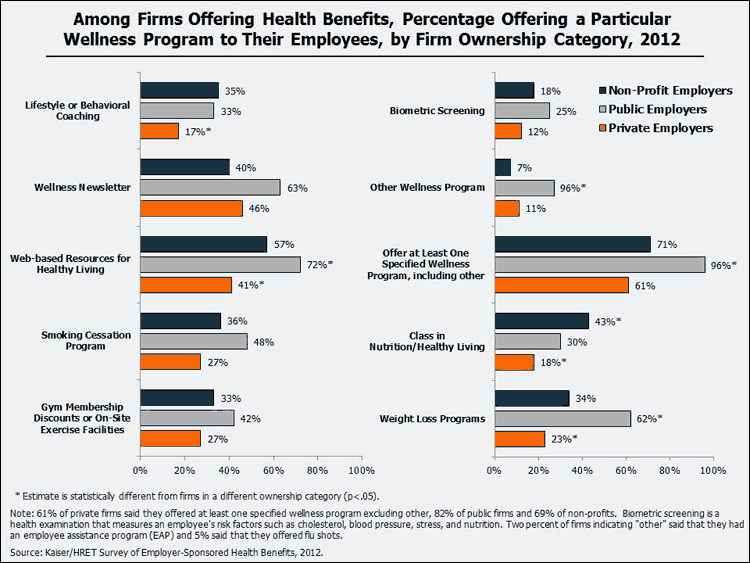
Conclusion
It is important to recognize that there is significant variation in the types of health plans being offered by employers within each of the ownership categories. On average, workers at private employers face higher employee premium contributions and cost sharing than their counterparts at public and non-profit employers. Even when comparing employers within large and small size categories, covered workers at public employers are responsible for a smaller portion of their coverage than workers at private employers.
Methods
The Employer Health Benefits Survey is a national probability survey of over 2,100 private and non-federal public employers with three or more employees. Non-federal firms are sampled from the 2007 U.S. Census of Governments and private sector firms are sampled by Survey Sampling Incorporated (SSI) which obtains information from Dun and Bradstreet. Employer industry classifications used in sampling are based on a firm’s primary SIC code. Employer ownership categories are defined by a survey question asking respondents to characterize their organization as a public, private, or non-profit employer. Weights are post stratified to industry; size and regional counts provided by the Census Bureau’s Statistics of U.S. Businesses and the Census of Governments. Interviews are conducted with HR directors and office managers about the firm’s HMO, PPO, POS, and HDHP/SO plan with the largest enrollment. For more information on the survey design and sampling methodology of the Employer Health Benefits Survey, see the Survey Design and Methods Section of the 2012 report 3 Statistical testing in this snapshot compares firms in one ownership category against all firms not in the indicated category at an alpha level of 0.05.
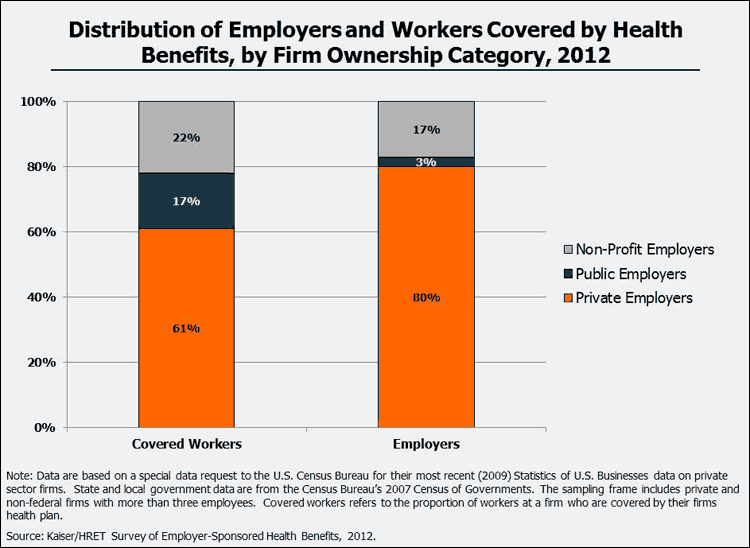
This snapshot was prepared by Matthew Rae, Nirmita Panchal, and Gary Claxton of the Kaiser Family Foundation’s Health Care Marketplace Project.
Notes:
- Less than 0.05% of respondents selected “don’t know” and were imputed using a hotdeck approach.
- Data are based on a special data request to the U.S. Census Bureau for their most recent (2009) Statistics of U.S. Businesses data on private sector firms. State and local government data are from the Census Bureau’s 2007 Census of Governments.
- The full report of the 2012 Kaiser/HRET Survey of Employer-Sponsored Health Benefits is available at http://www.kff.org/insurance/8345.cfm
